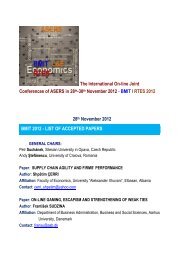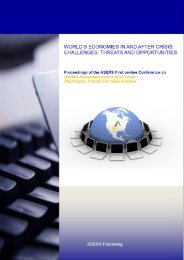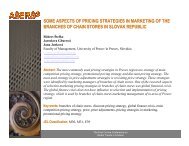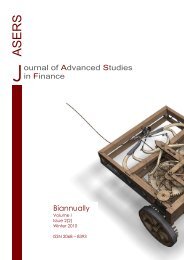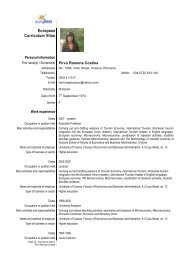Can Shift to a Funded Pension System Affect - ASERS
Can Shift to a Funded Pension System Affect - ASERS
Can Shift to a Funded Pension System Affect - ASERS
Create successful ePaper yourself
Turn your PDF publications into a flip-book with our unique Google optimized e-Paper software.
Theoretical and Practical Research in Economic Fields<br />
There is an ample debate on the role of this pillar given the fact that the 3-months moving average of M3,<br />
since the first months of 1999, has grown more than its established target. As a consequence, one could question<br />
if the monetary pillar really exists.<br />
Table 2 shows results obtained with the M3 gap as an explana<strong>to</strong>ry variable in the Taylor Rule. The formula<br />
estimated in this case is:<br />
i<br />
t<br />
<br />
<br />
) x ( M3gap<br />
)<br />
(3)<br />
0 1( t2<br />
2 t4<br />
3<br />
t2<br />
We can immediately note that coefficients on GDP gap and inflation gap have the right sign and are<br />
statistically different from zero. The reaction coefficient on M3 gap is not statistically significant and it is negative.<br />
If this value was right, we should have a Central Bank that performs an expansionary policy when M3 increases<br />
more than its optimal target (a similar result, i.e. a negative coefficient on the M3, is showed in Ullrich 2003).<br />
The emerging of this type of relation between the day-<strong>to</strong>-day rate and M3 rises many doubts over the role<br />
of the monetary aggregate in the conduct of the monetary policy by the ECB. It seems that the ECB does not pay<br />
so much attention <strong>to</strong> the fluctuations of this monetary aggregate. This result is in line with the findings of the<br />
papers by Fourçans and Vranceanu (2002) and Carstensen (2006).<br />
Moreover, the global results are quite disappointed. As we have noted for the basic model, it seems that a<br />
very simple rule, as the one used here, does not succeed <strong>to</strong> acceptably explain the course of the monetary policy<br />
over a long sample, even with the use of the M3 gap.<br />
We could have two alternative problems: the Taylor rule is not useful in this context or the regressors I<br />
have chosen are not completely correct.<br />
In sum, over this sample the Taylor Rule continues <strong>to</strong> provide useless information on the conduct of<br />
monetary policy in the Euro area. We can‟t use this formula as a benchmark <strong>to</strong> examine the monetary policy and<br />
<strong>to</strong> make some assumptions on the future path of the interest rate.<br />
6. The weight of the Dollar<br />
An ample political debate and many economic works have concerned the role of the exchange rates in the<br />
conduct of monetary policy, especially in the new framework of the European Monetary Union (see, for example,<br />
Carstensen 2006, Clarida, and Gertler 1996, Clarida, Galì, and Gertler 1998, Parsley, and Popper 2009, Engle<br />
2009). It is well known that the fundamental task of the ECB is <strong>to</strong> keep inflation low and so the mandate of the<br />
ECB does not explicitly include a supervision of the exchange rate fluctuations. As a consequence, the ECB<br />
should not directly care about the fluctuations of the exchange rates, when it decides the course of the interest<br />
rates (see art. 105 of the Treaty). That is, the aim of the ECB is not <strong>to</strong> control the course of the exchange rate.<br />
However, the path of the exchange rate can obviously be part of the analysis of the second pillar of the ECB‟s<br />
monetary policy.<br />
The just cited works have tried <strong>to</strong> find empirical evidences on the importance of the exchange rates in a<br />
Taylor-type rule. It is unquestionable that the exchange rates cover a crucial role in determining the speeding up<br />
and the slowing down of the economic cycle, mainly for the opened economies. But they also have an impact on<br />
the price level (through the pass-through effect). Even if these effects seem <strong>to</strong> be more mitigate than they were in<br />
the previous decades, we cannot disregard their existence and their possible impact on inflation.<br />
Moreover, with the onset of the monetary union the role of the exchange rates for the nations inside the<br />
EMU has strongly changed. Before the adoption of the Euro every EMU nations should care about many bilateral<br />
exchange rates within the European boundaries. From January 1999 the attention has been mainly directed <strong>to</strong><br />
the US Dollar – Euro bilateral exchange rate. Indeed, this exchange rate has now a central importance for the<br />
development of the European economic cycle.<br />
Let us consider, for example, that all the raw material (not only the energetic raw material but also the<br />
unprocessed agricultural products) are quoted in US Dollars. The nominal value of these goods changes if the<br />
Euro-Dollar exchange rate is fluctuating and this could have an impact on the domestic inflation. Furthermore, the<br />
United States are one of the most important market for the European exports.<br />
Besides, the importance of the Euro-Dollar exchange rate is increased by the strong linkage among Dollar<br />
and other national currencies all around the World. Indeed, there are many pegged exchange rates that have the<br />
US Dollar as an anchor (for example the Chinese yuan or the currencies of the OPEC). In this way an<br />
appreciation or a depreciation of the Euro <strong>to</strong>wards the Dollar has a strong impact on the value of other importexport<br />
flows and on other import prices.<br />
46



